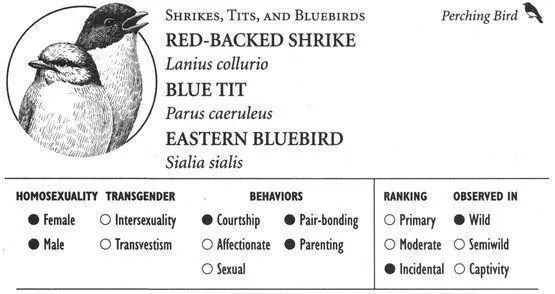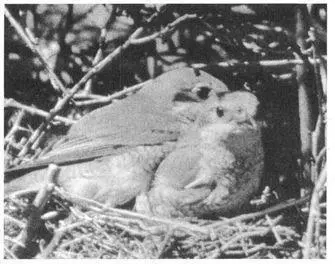Scottish Crossbills frequently engage in “symbolic” matings early in the breeding season, in which the male mounts the female but no genital contact occurs. Sometimes these mounts are promiscuous: several males other than the female’s mate may participate. Nonmonogamous matings are also fairly common in Chaffinches, often between neighboring birds. About 8 percent of all mating activity involves nonmates, and 17 percent of all offspring (in a quarter of all broods) result from such copulations. Occasionally, a pair will separate or “divorce” during the breeding season, after which the single female may copulate with several already paired males. Eventually, a polygamous trio may develop if one of these males forms a pair-bond with her in addition to his own mate. Some Scottish Crossbills are also polygamous, forming trios of one male with two females. In this species, parents (in monogamous pairs) regularly become single parents: they separate when their young are able to fly, dividing the young between them and raising them on their own. Because the mother and father often travel to widely separated feeding grounds, youngsters belonging to the same family may be raised in very different environments. Occasionally, unrelated birds—both males and females—help feed and “foster-parent” the young birds after their biological parents have separated.
Sources
*asterisked references discuss homosexuality/transgender
Adkisson, C. S. (1996) “Red Crossbill ( Loxia curvirostra ).” In A. Poole, P. Stettenheim, and F. Gill, eds., The Birds of North America: Life Histories for the 21st Century, no. 256. Philadelphia: Academy of Natural Sciences; Washington, D.C.: American Ornithologists’ Union.
Halliday, H. (1948) “Song of Female Chaffinch.” British Birds 41:343-44.
Hanski, I. K. (1994) “Timing of Copulations and Mate Guarding in the Chaffinch Fringilla coelebs.” Ornis Fennica 71:17–25.
Kling, J. W., and J. Stevenson-Hinde (1977) “Development of Song and Reinforcing Effects of Song in Female Chaffinches.” Animal Behavior 25:215–20.
Knox, A. G. (1990) “The Sympatric Breeding of Common and Scottish Crossbills Loxia curvirostra and L. scotica and the Evolution of Crossbills.” Ibis 132:459—66.
*Marjakangas, A. (1981) “A Singing Chaffinch Fringilla coelebs in Female Plumage Paired with Another Female-Plumaged Chaffinch.” Ornis Fennica 58:90–91.
*Marler, P. (1956) Behavior of the Chaffinch Fringilla coelebs. Behavior Supplement V. Leiden: E. J. Brill.
———(1955) “Studies of Fighting in Chaffinches. 2. The Effect on Dominance Relations of Disguising Females as Males.” British Journal of Animal Behavior 3:137—46.
*Nethersole-Thompson, D. (1975) Pine Crossbills: A Scottish Contribution. Berkhamsted: T. and A. D. Poyser.
Sheldon, B. C. (1994) “Sperm Competition in the Chaffinch: The Role of the Female.” Animal Behavior 47:163–73.
Sheldon, B. C., and T. Burke (1994) “Copulation Behavior and Paternity in the Chaffinch.” Behavioral Ecology and Sociobiology 34:149–56.
Svensson, B. V. (1978) “Clutch Dimensions and Aspects of the Breeding Strategy of the Chaffinch Fringilla coelebs in Northern Europe: A Study Based on Egg Collections.” Ornis Scandinavica 9:66—83.
Voous, K. H. (1978) “The Scottish Crossbill Loxia scotica .” British Birds 71:3–10.

RED-BACKED SHRIKE
IDENTIFICATION: A small (6½ inch) bird with a thick, hooked bill, grayish brown plumage, and a darker facial mask (black in males). DISTRIBUTION: Throughout Eurasia and northeast Africa; winters to southern Africa. NABITAT: Savanna, woodland, scrub, farmland. STUDY AREA: New Forest, Hampshire, England.
BLUE TIT
IDENTIFICATION: A tiny (4½ inch) chickadee-like bird with a bright blue crown, black-and-white face, bluish green plumage, and yellow underparts. DISTRIBUTION: Europe, Middle East, North Africa. HABITAT: Woodland, human habitation. STUDY AREA: Marley Wood, Oxfordshire, England; subspecies P.c. obscurus.
EASTERN BLUEBIRD
IDENTIFICATION: A sparrow-sized bird with bright blue plumage, white underparts, and a chestnut throat and breast. DISTRIBUTION: North and Central America. HABITAT: Open woodland, orchards, farmland, pine savanna. STUDY AREA: In the town of Washington, Michigan.
Social Organization
Red-backed Shrikes generally establish monogamous pair-bonds during the mating season and occupy partially overlapping territories. Outside of the breeding season, the birds are more solitary, and males and females typically occupy segregated habitats (males in more open bush country, females in more dense woodland). Blue Tits and Eastern Bluebirds are also territorial and form pair-bonds, but may associate in flocks outside of the breeding season.
Description
Behavioral Expression: In Red-backed Shrikes and Blue Tits, two females sometimes pair with each other, build a nest, and lay eggs. Both partners in Red-backed Shrike homosexual pairs take turns incubating the eggs (in heterosexual pairs, only the female incubates). Sometimes they even sit on the nest together, side by side or one partially covering the other. Both females also lay eggs: as a result, their nests have SUPERNORMAL CLUTCHES of 9–12 eggs, twice the number in most nests belonging to heterosexual pairs. If their nest is robbed by predators, the pair will dutifully build a second one (often in a much higher location, to make it inaccessible to most ground predators) and begin laying eggs again (as do male-female pairs when they lose a nest). However, all of the eggs they lay are typically infertile since neither female has mated with a male, and the pair usually abandons the nest after the eggs have failed to hatch. Blue Tit female pairs are unlike most homosexual pairs in birds because only one female lays eggs. As a result, nests belonging to such pairs contain not supernormal clutches, but exceptionally small clutches of 3 or so eggs (nests of male-female pairs typically contain about 11 eggs). Both females incubate the eggs simultaneously, sitting together on the nest facing in the same direction. As in Red-backed Shrike homosexual pairs, the eggs are usually infertile and the pair eventually abandons the nest.
A nesting pair of female Red-backed Shrikes in England simultaneously incubating their eggs

In Eastern Bluebirds, two males sometimes associate with one another in what appears to be a homosexual pair-bond: they travel exclusively in each other’s company (perhaps even spending the winter together), jointly inspect nest sites during the early spring, and court one another. The latter activity involves COURTSHIP-FEEDING—a behavior also seen in heterosexual pairs—in which one male offers a symbolic food gift, such as a cutworm, to the other male, often preceded by a distinctive call. Paired males might be related to each other (father-son or brothers). Occasionally, a female who has lost her heterosexual mate is joined by another female, who helps coparent her offspring. The two birds take turns feeding the youngsters and may also be assisted by one or more of their young from a previous brood.
Читать дальше














